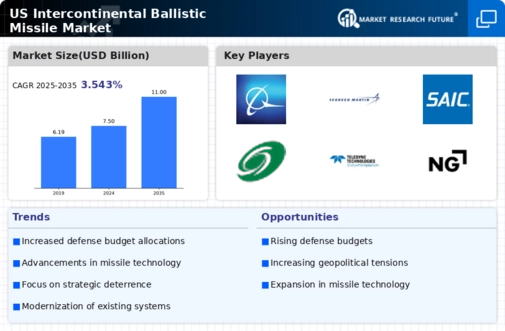Strategic Defense Initiatives
The intercontinental ballistic-missile market is significantly influenced by the strategic defense initiatives undertaken by the US government. These initiatives aim to enhance national security and deter potential threats from adversarial nations. The US has allocated substantial funding, estimated at over $20 billion annually, towards the development and modernization of its missile defense systems. This investment not only bolsters the capabilities of the intercontinental ballistic-missile market but also fosters innovation in missile technology. As the geopolitical landscape evolves, the emphasis on strategic defense initiatives is likely to drive demand for advanced intercontinental ballistic missiles, ensuring the US maintains its military superiority.
International Arms Control Agreements
International arms control agreements significantly impact the intercontinental ballistic-missile market by shaping the regulatory landscape within which the US operates. Treaties such as the New START agreement influence the development and deployment of missile systems. While the US has historically engaged in arms control negotiations, the evolving geopolitical climate may lead to shifts in these agreements. The potential for new treaties or the withdrawal from existing ones could create fluctuations in the intercontinental ballistic-missile market. As the US navigates these complex dynamics, the market may experience changes in demand based on compliance with international regulations.
Emerging Threats and Security Concerns
The intercontinental ballistic-missile market is propelled by the emergence of new threats and security concerns that challenge US defense strategies. Nations such as North Korea and Iran have demonstrated advancements in missile technology, prompting the US to reassess its defense posture. The potential for missile proliferation and the development of sophisticated delivery systems necessitate a robust response from the US military. Consequently, the intercontinental ballistic-missile market is expected to experience growth as the government invests in countermeasures and advanced missile systems. This focus on addressing emerging threats is likely to shape the future landscape of the intercontinental ballistic-missile market.
Technological Integration and Innovation
Technological integration and innovation play a crucial role in shaping the intercontinental ballistic-missile market. The US military continuously seeks to incorporate cutting-edge technologies, such as artificial intelligence and advanced materials, into missile systems. This integration enhances the performance, accuracy, and reliability of intercontinental ballistic missiles. Recent reports indicate that the US defense budget allocates approximately $15 billion for research and development in missile technology. As these innovations materialize, they are expected to drive the intercontinental ballistic-missile market, ensuring that the US remains at the forefront of missile defense capabilities.
Defense Budget Allocations and Military Spending
Defense budget allocations and military spending are pivotal drivers of the intercontinental ballistic-missile market. The US government consistently prioritizes defense expenditures, with the fiscal year 2025 budget proposing an increase of approximately 5% for missile defense programs. This financial commitment underscores the importance of maintaining a robust intercontinental ballistic-missile capability. As military spending continues to rise, the intercontinental ballistic-missile market is likely to benefit from increased investments in research, development, and procurement of advanced missile systems. This trend suggests a sustained focus on enhancing national security through strategic military capabilities.

















Leave a Comment